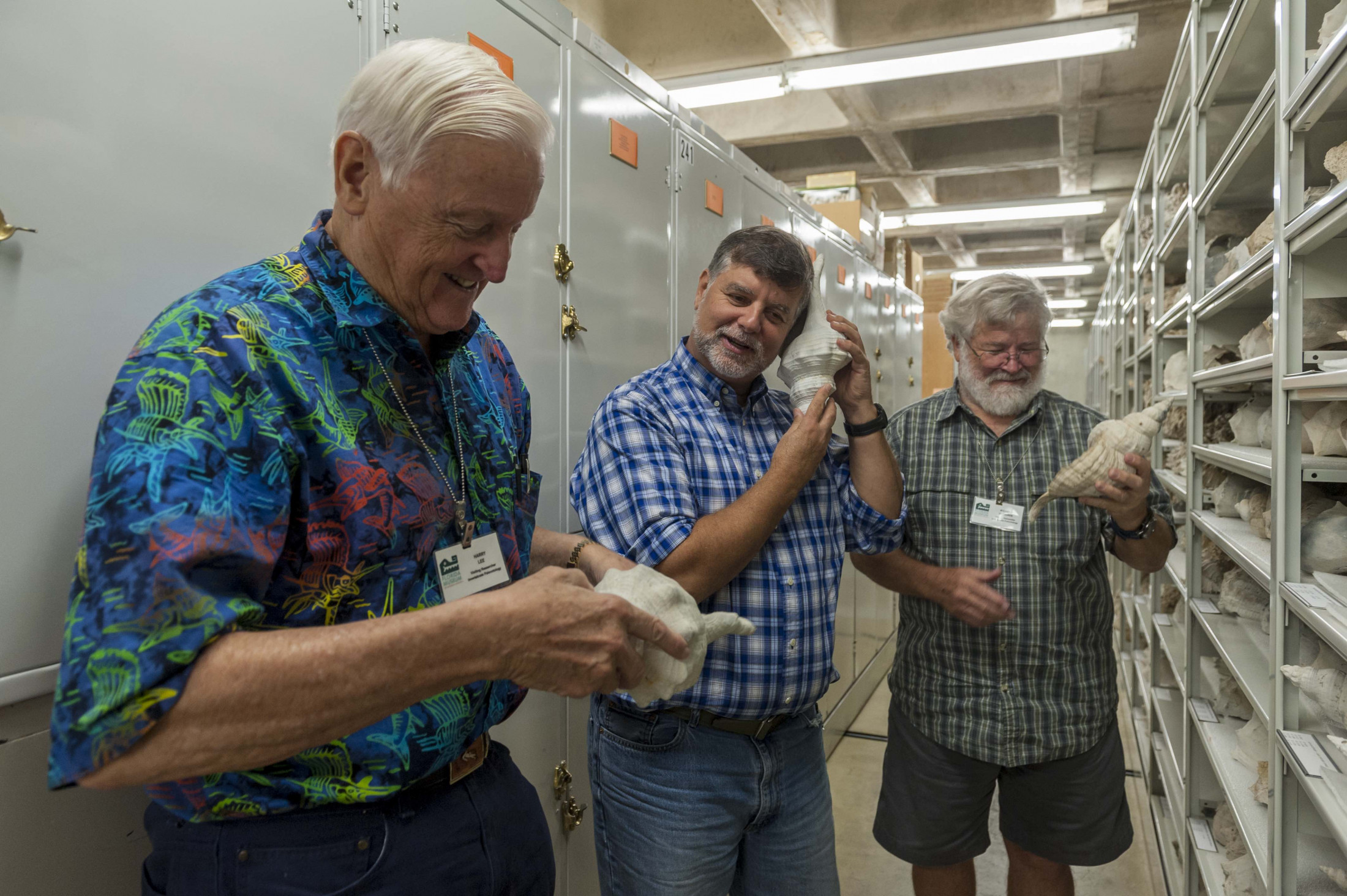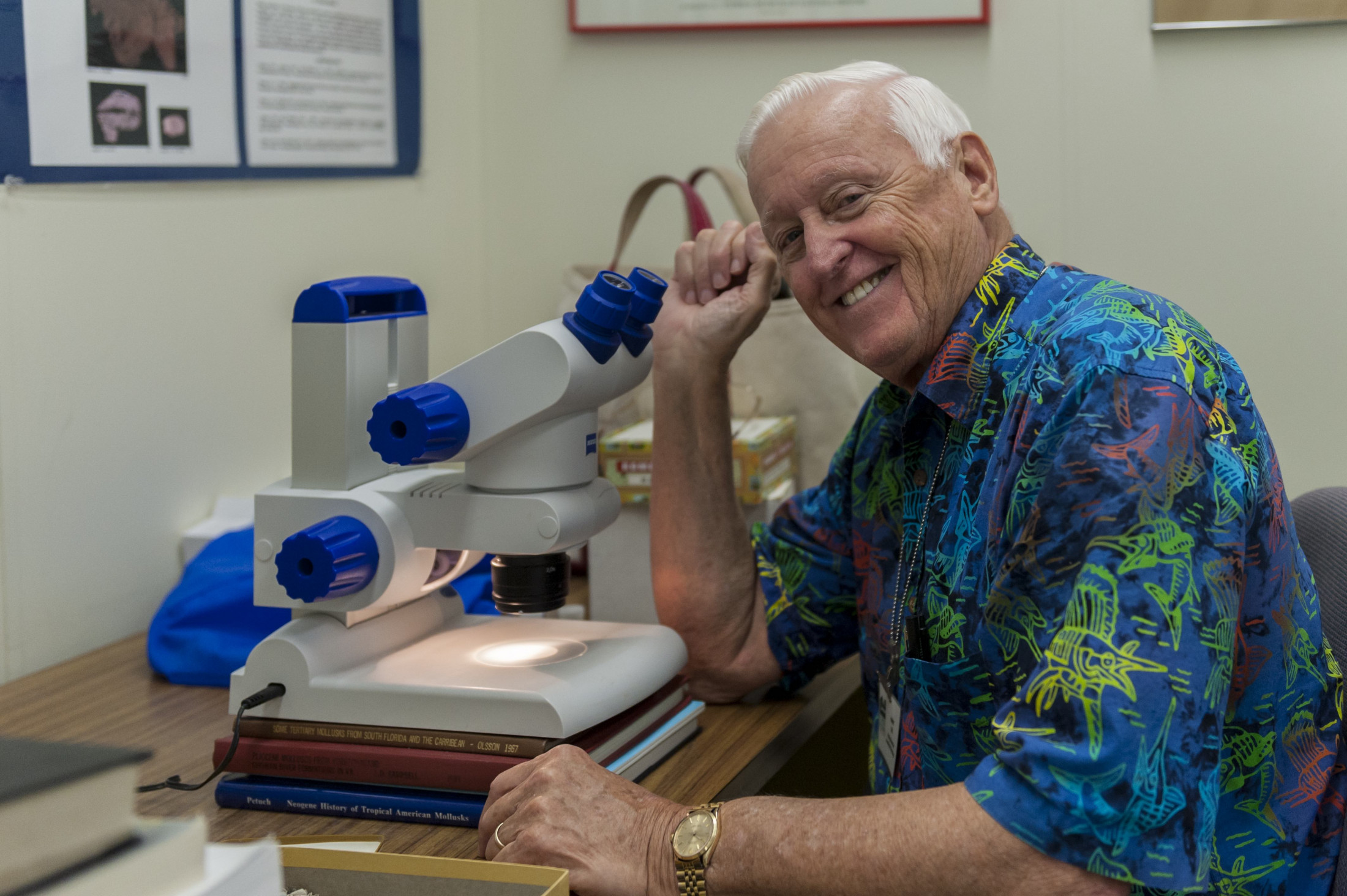In his book, “The Immense Journey,” anthropologist Loren Eiseley wrote, “If there is magic in this world, it is contained in water.” There are few people who seemed to have grasped this truth as completely as Harry George Lee of Jacksonville, Florida, a physician, globe-trotter, researcher and an avid enthusiast of mollusks.
“He lived for mollusks,” said Roger Portell, director of the invertebrate paleontology collection at the Florida Museum of Natural History. “He started collecting when he was 6 years old, and his passion seldom waned.”
Lee passed away this year due to complications from a stroke, leaving behind a storied legacy and nearly a million shells, which he bequeathed to the Florida Museum in 2010.
During his life, his passion for shells grew, took on new dimensions and opened avenues down which he tirelessly traveled. He maintained international correspondence with scientists, amateur shell collectors and novices, through which he shared his expertise, exchanged specimens and contributed extensively to the scientific study of mollusks, called malacology. He published dozens of peer-reviewed publications, named and described 36 new species, and had 18 species named for him, with more still to be named.
Florida Museum photo by Kristen Grace
Perhaps the most remarkable thing about his career is that he wasn’t a scientist by trade. Lee was a physician and ran an internal medicine practice for three decades. He rose to prominence in the malacology ranks by dedicating much of his evenings and weekends to the study of shells, learning and contributing more to the field during his free time than some professional biologists accomplish throughout their entire careers.
“There are a few people who are passionate about science who do not follow it as a vocation but instead are forced or choose to do something else,” said Kurt Auffenberg, a former collection manager at the Florida Museum who worked closely with Lee periodically beginning in the early 1980s. “Instead, they come to science as an avocation, and they’re in all biological disciplines: shells, reptiles, birds, etc. They might be female or male, a doctor, dentist, engineer; it doesn’t matter.”
These individuals, Auffenberg attests, the ones who linger on the margins of scientific practice and who have only their spare time and energy to devote, have pushed knowledge beyond measure since the days of Carl Linnaeus.
Physicians, because of their training in biology and interest in the curiosities of life, have had a great influence on the science of conchology. – R. Tucker Abbott, “Shells”
The comparison is apt. Linnaeus was also a physician by training but is most famous for establishing the modern system of binomial nomenclature, whereby every species is classified and referred to by its genus and specific epithet. Linnaeus named more species than any other biologist before or since. In the 10th edition of his “Systema Naturae,” published in 1758, he gave names to roughly 700 mollusks, including many of the species with which Lee would later become fascinated. The shell that started Lee’s collection — a smooth, rounded tiger cowrie — was given the Latin name Cypraea tigris by Linnaeus. Lee was given the specimen by a retired scissors-maker who kept his own sprawling collection distributed throughout a two-story house across from the home of Lee’s grandmother’s, which left a lasting impression.

Floridad Museum photo by Kristen Grace
Lee wasn’t content with studying species that had already been given the binomial rubberstamp by those who came before him. He seemed to have an unquenchable thirst for the unknown, which drove him along neglected paths that even professional malacologists consider to be on the hazy periphery of their profession.
After retiring as a physician, he began volunteering at the Florida Museum, where he sifted through fossils so small they had to be scanned with an electron microscope to be adequately visualized. He picked the specimens, mounted a portion on button-sized titanium stubs, and learned to operate the electron microscope himself.
It is perhaps a more fortunate destiny to have a taste for collecting shells than to be born a millionaire. Although neither is to be despised, it is always better policy to learn an interest than to make a thousand pounds; for the money will soon be spent, or perhaps you may feel no joy in spending it; but the interest remains imperishable and ever new. – Robert Louis Stevenson, “Lay Morals”
When author and journalist Cynthia Barnett was conducting research for a book on shells, she naturally reached out to Lee and thought they’d meet at his home, where he kept his colossal collection. Instead, she wrote, they spent most of their time together at the museum, where he busily sorted specimens. “The tiny white conchs, horns, and tulips, many extinct, are delicate miniatures of the shells he has collected since boyhood. They came from a 3-million-year-old layer of the Pliocene, the era named by Charles Lyell to describe when modern marine mollusks in the fossil record—the shell shapes we recognize—begin to outnumber those that are extinct.”
Images taken by Harry Lee
Lee became more deeply interested in tiny fossil shells after reading a study co-authored by Roger Portell, in which an historical estimate is provided of marine micromollusk diversity along the Atlantic Coastal Plain. He asked Portell if he’d ever tested to see how accurate his estimation was.
“I said ‘no, it would be too time-consuming,’ and that started the quest.”
Lee made the drive from Jacksonville, Florida, to the museum in Gainesville once a week, most often accompanied by his friend Rick Edwards, a retired teacher and fellow shell aficionado. Edwards sifted through buckets of shell and sediment scarcely larger than sand grains, separating the shells from the limestone matrix they’d nestled in for millennia.
“I call these my treasure hunts, because I find things only I have ever seen before,” Edwards said. “Harry could tell just by looking at a shell whether it was a new species or not.”
Lee had a similar collection of modern micromollusks at home, which he assiduously collected, sorted and identified.
“He had a lot of small things that most people ignore,” said John Slapcinsky, collection manager of invertebrate zoology at the Florida Museum. Friends sent him bags of sand they’d collected while diving in various locations, and he’d focus his attention on picking out the cones, turrets and helices hidden inside.
“Most museums don’t have a lot of that material, because they don’t have the resources to put into it,” Slapcinsky said. “He was willing to spend thousands of hours sorting.”
…I caught a glimpse of a beautiful shell, imprinted with what appeared to be strange writing, rolling in the breakers. Golden characters like Chinese hieroglyphs ran in symmetrical lines around the cone…I lifted it up with utmost excitement, as though a message had come to me from the green depths of the sea. Each man deciphers from the ancient alphabets of nature only those secrets that his own deeps possess the power to endow with meaning. It had been so with Darwin and Thoreau. The golden alphabet, in whatever shape it chooses to reveal itself, is never spurious. From its inscrutable lettering is created man and all the streaming cloudland of his dreams. – Loren Eiseley, “The Unexpected Universe”
Eventually, even the innumerable tiny shells couldn’t contain Lee’s hunger for ever-more expansive and esoteric horizons. If there were few people who study micromollusks, there are even fewer who focus on diminutive bivalves, referred to by malacologists as LWCFs — little white clam fossils. These are so small and non-descript that only those with a unique mix of discernment and dogged commitment have the patience to work on them.
“At least with gastropods, you have enough sculpture that you can do something with it,” Portell said. “With the little white clams, it’s really tough. It requires a lot of focus, energy and effort.” All qualities that Lee had in abundance.

Florida Museum photo by Kristen Grace
The shells he catalogued and those he left to the Florida Museum are an invaluable portal to the natural world, one that will help future researchers track our planet’s shifting diversity and perhaps stave off the worst of its declines. But they’ll do so at a disadvantage, without the benefit of having the talented physician and naturalist who accrued the specimens and helped make sense of them.
“He was the most intelligent person I’ve ever met, without a doubt,” Auffenberg said. “He was an amazing human. There’s a void in the cosmos and scientific world that was filled by Harry Lee, and I feel it. I’m sure many other people do, too.”